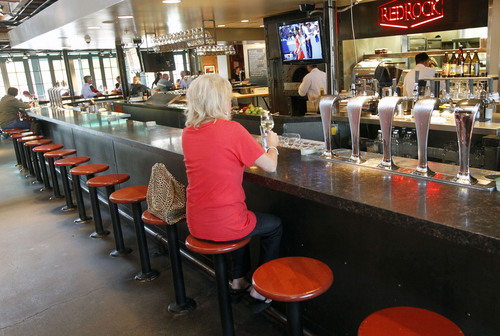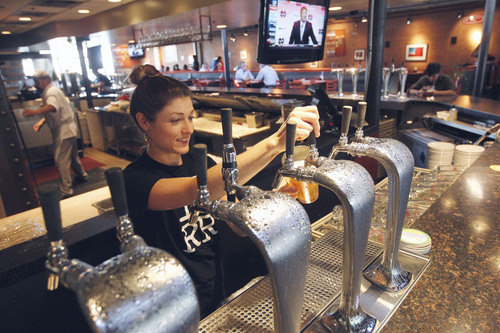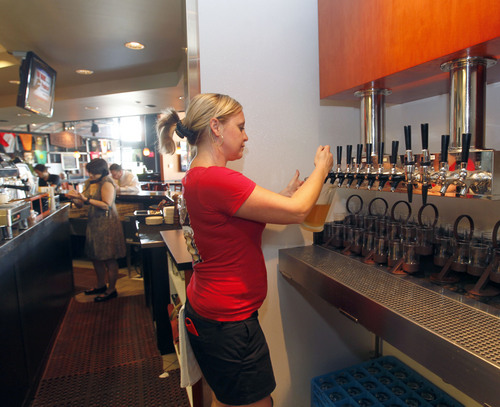This is an archived article that was published on sltrib.com in 2013, and information in the article may be outdated. It is provided only for personal research purposes and may not be reprinted.
Murray • Under Utah's complex array of liquor laws, Red Rock Brewery was required to erect barriers dubbed a Zion curtain to hide bartenders and beer taps from public view.
When the pub opened in April 2011 at Fashion Place Mall, owners applied for a coveted bar license, which allows patrons to watch bartenders mix drinks, pour a cold one from a tap or open bottles of beer. But an acute shortage of these permits forced Red Rock to make do with a restaurant license.
In June, after waiting more than two years, commissioners overseeing the Utah Department of Alcoholic Beverage Control awarded Red Rock a bar license, which means its two barriers could come down.
Later this fall, the pub will call in construction crews for a yet-to-be-determined cost to tear down the 12-foot-by-8-foot room and another 7-foot-by-3-foot partition built at each end of a counter. Both partitions are 8 feet tall.
"It's a matter of display and of promoting who we are — which is a brew pub," said the pub's general manager Kim Hardle. "Covering up what we do doesn't make any sense."
Red Rock Brewery, whose beers have earned more than 100 regional and national awards, illustrates the challenges the uniquely Utah barriers and the associated tangle of liquor licenses and laws pose to the state's growing restaurant and hospitality industry.
Red Rock's downtown pub, with its signature long, curved bar, has been a staple of Salt Lake City for nearly 20 years, opening at a time when club (also called bar) permits were easier to obtain.
Red Rock's Park City pub also operates without a Zion curtain because stricter laws requiring the barriers were not enacted when it opened in 2005.
Then there are restaurants built before 2010 that are exempt from building Zion curtains, which many in the industry say gives them a competitive edge.
Tougher laws • Since the 1960s state laws have required some sort of Zion curtain at restaurants that serve alcohol. But in 2010, Sen. John Valentine, R-Orem, beefed up the statute to ensure that bartenders and open liquor bottles would be completely obscured from public view. He also helped sponsor additional legislation making it illegal in beer-only restaurants licensed after August 2011 to open bottles of beer in public view "to keep a continuity among the statutes."
Valentine has long made it plain that he regrets exempting older restaurants from the law. He said he has no plans to introduce legislation requiring the more than 500 exempted restaurants to erect Zion curtains. But some in the industry see his statements as a threat to restaurant owners who speak out against barriers.
Melva Sein, CEO of the Utah Restaurant Association, said it would have cost $100,000 for each existing restaurant to change structures and undergo renovations to build walls, a requirement that would have harmed businesses. She added that her group will continue pushing to do away with the state's peculiar Zion curtains "because there is no research, no study, no statistics to show bar settings in restaurants influence minors or anyone else to drink."
Valentine doesn't see it that way.
Through the years, said Valentine, restaurants began looking more like bars, raising concerns about underage drinking and drunk driving — requiring his stricter legislation. Specifically, lawmakers cited see-through barriers and bar-like settings in many restaurants. Cheesecake Factory and Chili's were singled out as examples.
In an effort to stop that trend, existing restaurants exempted from the Zion curtain law could receive up to a $30,000 credit in liquor purchases if they erected barriers to cover up their bars or build back rooms to keep liquor out of sight. But the incentive proved unpopular — of the 374 eligible restaurants only one, Xetava Gardens Cafe in Ivins, received the credit.
Owner Greg Federman said he took advantage of the incentive because he was remodeling the southern Utah restaurant and needed an area to store beer and wine. He doesn't serve distilled spirits so he wouldn't run into complaints from customers objecting to bartenders mixing drinks in a back room.
"Complying with the law didn't affect us one way or another," he said of his business. "And I was thrilled to get the incentive."
Federman added, however, that he would like to someday get a club license to serve tourists accustomed to ordering an alcoholic beverage without a meal, as long as it didn't violate terms of receiving the credit.
Red Rock's Park City pub also is on the waiting list for a bar license in part because it too would like to serve patrons a drink without requiring them to order food, which the establishment cannot do under its restaurant license.
Competition and consequences • Other restaurant owners have complained that Zion curtains are hurting their business. They say many of the 438 new establishments required to build barriers are unfairly competing with 511 older eateries that were exempted when the law went into effect in 2010.
One unintended consequence of the array of laws is that high-end resorts and fine dining restaurants now are competing with bars for the coveted club licenses. But no permits were available in 2011, five permits became available in 2012 and so far this year, six licenses have been awarded. As many as 22 applicants have been on a waiting list.
The number of permits are based on the state's population, and do not take into account the 20 million tourists who visit — and dine — in Utah annually.
Bar licenses themselves — which are separated into social and dining clubs — can befuddle out-of-state visitors and add to the state's acute shortage of permits.
Liquid Joe's in Salt Lake City, for example, holds a social club license, meaning no minors are allowed and food is not required to be sold. But Squatters Brewery Pub has a dining club permit, allowing minors when accompanied by an adult and requiring 60 percent of sales to be from food.
Valentine acknowledged both bars and fine dining restaurants are competing for club licenses. But he added that at some point he may revisit the requirements so that minors may not be allowed in any establishment that holds a club license.
"There must be a distinction between a bar and a restaurant," said Valentine. "There's too much of a push to make restaurants look like bars, and that could promote liquor sales."
Rise of the barriers • The history of Utah's unique restaurant partitions can be traced to 1968. At that time, The Church of Jesus Christ of Latter-day Saints, which preaches against alcohol, successfully urged voters to kill an initiative that would have allowed the sale of liquor by the drink in restaurants.
As a compromise, diners could bring liquor minibottles to restaurants — as long as the liquor was not visible to other patrons.
By 1990, the minibottle law was repealed in favor of bartenders pouring individual drinks. To avoid over-the-counter-service, waiters had to bring drinks to diner's tables. The following year, diners were allowed to order drinks at restaurant counters, as long as the liquor was not served or mixed there.
To comply, restaurants built back rooms with small windows where servers picked up the beverages. Other eateries built a hodge-podge of horizontal or perpendicular walls and still others erected see-through partitions of varying sizes.
Regulations became so convoluted that in 2009, liquor-control commissioners said the law couldn't be enforced and in some cases didn't make any sense. For instance, bartenders at Stella Grill in Murray could not hand glasses of water over to patrons seated on the other side of a short counter-top partition, and severs, not bartenders, had to walk around the counter to serve alcoholic beverages.
In 2009 lawmakers did away with private club memberships, and as part of the compromise required restaurants to build barriers to hide bartenders and open liquor bottles — reminiscent of rules from the 1960s requiring minibottles and beer taps to be out of public view.
At times bills have been introduced to do away with Zion curtains, but the Legislature, whose majority is comprised of LDS Church members, has yet to ease requirements that aim to shield their non-drinking constituents from those who do.
twitter@DawnHouseTrib —
Zion curtain
New eateries must build barriers to hide bartenders from public view.
Number of eateries open since 2010 when law went into effect:
235 • Eateries serving all types of alcohol
139 • Restaurants serving beer and wine
64 • Beer only restaurants
Number of older restaurants exempt from the barrier law:
304 • Eateries serving all types of alcohol
124 • Restaurants serving beer and wine
83 • Beer only restaurants







